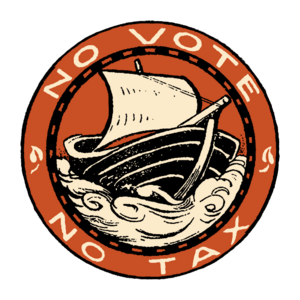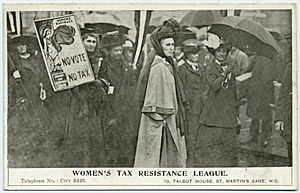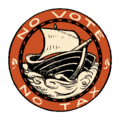Women's Tax Resistance League facts for kids
The Women's Tax Resistance League (WTRL) was a group in Britain from 1909 to 1918. They were part of the larger movement fighting for women's right to vote, known as the women's suffrage movement.
The WTRL used a special way to protest: they refused to pay taxes. This was their way of saying, "No vote, no tax!" They believed it was unfair to pay taxes if they didn't have a say in how the country was run.
Dora Montefiore first suggested forming this group in 1897. The league officially started on October 22, 1909. Their protests were strongest before the First World War. However, when the war began in 1914, the group decided to pause their tax resistance for a while.
More than 220 women took part in this tax resistance. Most of them were middle-class. Some even continued their protest during the war, even though the group had officially stopped.
Contents
Why They Resisted Taxes
In 1913, Beatrice Harraden, a member of the league and an author, explained their reasons:
The least any woman can do is to refuse to pay taxes. This is especially true for taxes on money they earned themselves. It's the most logical part of the fight for the right to vote. It's completely unfair and silly for the government to ask us to pay income tax on money we earn with our brains, when they won't even let us vote.
The league started with a clear slogan: "No vote, no tax." It included women from different suffrage groups. They all came together to refuse taxes.
How They Protested
When women refused to pay taxes, the government sometimes took their belongings. They would then sell these items at an auction to get the money owed. The WTRL turned these auctions into public events and protests.
For example, in 1906, there was a famous event called the "Siege of Montefiore." Dora Montefiore refused to pay her taxes. She and her maid blocked the doors of her house against the officials. For six weeks, Montefiore resisted. She often spoke to the crowds gathered outside from her upstairs windows.
The Case of Elizabeth Wilks
Elizabeth Wilks was the treasurer of the league. In 1908, she also refused to pay her tax. At that time, married women in Britain were not required to pay tax directly. Instead, a couple's income was added together, and the husband paid the tax.
Elizabeth earned more than her husband, Mark. She refused to tell him how much she earned. This caused a problem for the authorities. Elizabeth wasn't legally responsible for the tax, and her husband said he would pay, but he didn't know the amount.
In 1910, officials illegally took some of Elizabeth's goods. They tried to collect the tax from her income. Mark Wilks was then asked to pay tax on an income he didn't know about.
About 3,000 teachers signed a petition when Mark Wilks was held. A large protest took place in Trafalgar Square. Mark was released after two weeks. Supporters of the Women's Tax Resistance League, including George Bernard Shaw, celebrated his release.
When members' goods were auctioned, small parades and celebrations often followed. Supporters would give public speeches from decorated carriages. They used these moments to explain their protest to everyone.
Even though the House of Lords discussed how unfair the law was, British law didn't change until 1972.
Who Were the Members?
Many brave women were members of the WTRL or had their goods auctioned for refusing to pay taxes. Here are some of them:
- Janie Allan
- Sarah Benett
- Anne Cobden-Sanderson
- Charlotte Despard
- Dr. Margaret Dobson
- Mary Sargant Florence
- Katharine Gatty
- Cicely Hamilton
- Beatrice Harraden
- Kate Harvey
- Clemence Housman
- Edith How-Martyn
- Emily Juson Kerr
- Dora Montefiore
- Anna Munro
- Dorinda Neligan
- Margaret Nevison
- Princess Sophia Duleep Singh
- Flora Annie Steel
- Elizabeth Wilks
- Edith Zangwill
- Stanton Coit (who was part of the "men's branch" of supporters)
Tax Resistance in the United States
The women's suffrage movement in the United States also used similar methods. Anna Howard Shaw, a leader in the American movement, said it was unfair for women to be taxed without having a voice in government.
She encouraged women to use "passive resistance," like the Quakers. She said, "I believe that the spirit of 'no taxation without representation' that led to the Revolutionary War is just as strong in the women of this country as it was in the men back then."
Images for kids





